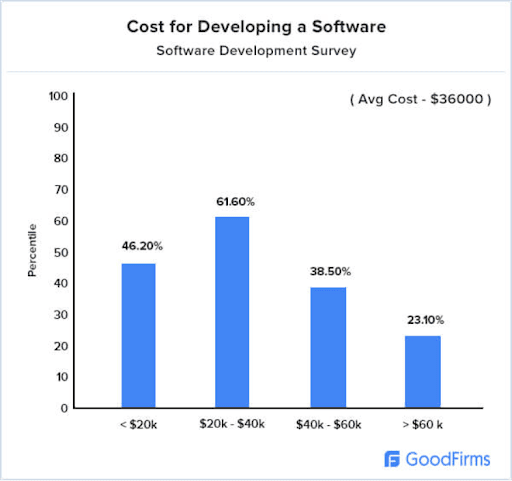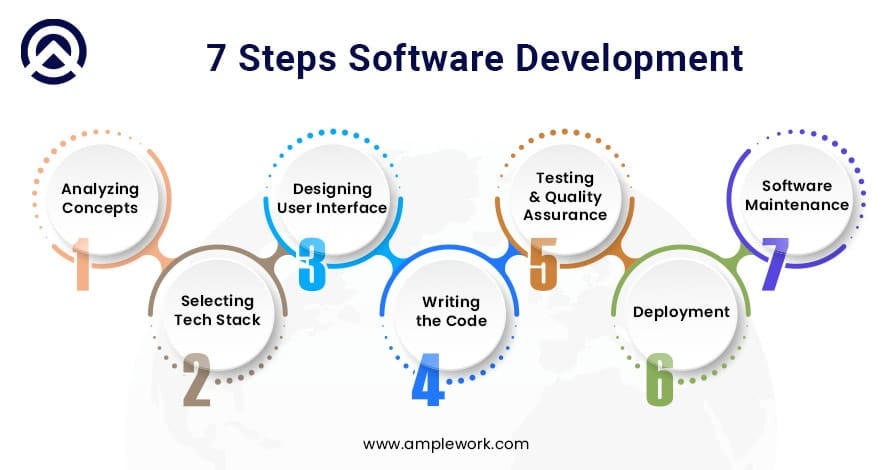Step By Step Process of Software Development
The world around us is powered by software. From the apps on our phones to the complex systems running businesses, software development is the magic behind it all. But how exactly does an idea transform into a functioning piece of software? Well, it requires a complete sequence or you can say series of steps. These steps involve a fascinating process that transforms concepts into functional software. Transforming the ideology into a complete real-world solution requires the need and requirement of a complete software development life cycle that starts from the conceptualization and ends with the deployment process.
The software development process follows a structured approach, with the choice of method depending on the user’s requirements. These approaches are waterfall, spiral, and incremental approach. Each approach comprises a similar basic concept that includes almost the same software development process. This blog will unveil the step-by-step journey of software development, guiding you from the initial spark of an idea to its final execution in the real world. We’ll explore how software goes from a problem statement to a well-defined plan, before diving into the stages of design, coding, testing, and deployment.
Here are a Few Considerations for Comprising Statistical Data
According to a research survey conducted by a well-known organization, GoodFirms has generated a wide range of facts, related to the software development process. According to their research data the software development cost ranges from $3000 to $120,000. It completely depends on the project’s complexity and the requirement of custom features and functionalities required by users. According to their data, around 46.2% of the software development companies proclaimed that they are delivering custom software engineering services with basic features and functionalities at a price range that lies under $20,000. Although the highest number is approx. 60.6% of firms offer software projects with general features and functionalities at a price range of $20,000 to $40,000.
However, most software development firms charge a range of amounts that lie between $40,000 to $60,000 for a sophisticated custom software engineering project. Finally, around 23.1% of firms cater to their clients with software packages at a price range that lies over $60,000.

Step By Step Process of Software Development
Since mobile app development services comprise a vast process that involves a set of steps to shape an innovative idea into a real-world software solution. So let’s explore the step-by-step process of software development that needs to be followed to deliver your clients with a robust and best-in-class software solution.

1. Analyzing Concepts:
The first step in software development steps is about understanding the purpose of software development. This involves gathering the project-related requirements from both stakeholders and clients. For the same data collection, you can take meetings, and interviews and also perform research about the latest market trends and user requirements. Also clarify queries like, What is the actual problem that the client is trying to solve through their desired solution? Who are the targeted audiences and what are their preferences? And many other aspects.
2. Selecting Tech Stack:
With a clear understanding of the project requirements, for developing software according to the user’s requirements, further, you need to select the perfect tech stack that perfectly meets the user’s requirements. Also, you need to plan accordingly for incorporating the software architecture, user interface, and user experience as well. Defining and selecting a correct tech stack for the same is a must to ensure the seamless functioning of the solutions according to the user’s requirements.
3. Designing User Interface:
Custom software engineering services starts acquiring the shape in terms of software design. The designing team creates a detailed user interface design that completely outlines the actual architecture of the software, addressing the user interface and defining the actual user experience. For the same purpose, wireframes, mockups, and prototypes are often used to visualize the user journey, ensuring the software design is robust, intuitive, and user-friendly as well. That’s the reason why it is considered one of the most important processes of the software development lifecycle as it defines the functioning of software or applications.
4. Writing the Code:
After the design is completed and finalized by the client, the next what you have to do is just start writing the code to start the software development process. It is the software development process where the programmers take center stage. Armed with the decision documents, they translate the software’s functionalities into code using specific programming languages, depending on the selection and integration of the tech stack. Also, the version control systems are used to track changes and ensure smooth collaboration amongst developers. Ensuring the development of the most efficient software engineering services.
5. Testing & Quality Assurance:
Once the developers complete the coding software development processes the next core phase comes in which the team of testers rigorously tests the software. The testers identify and fix the existing bugs and errors to ensure the software functions as intended. Implementing the different software testing mechanisms such as unit testing, integration testing, and finally user acceptance testing are deployed to catch any sort of errors during the development process at every particular stage.
6. Deployment:
It is considered the final moment of software development processes. This phase states that the software is finally ready to be released for the users. Involves the process of deployment of the same aspect on the server, app store, or making it available for download. Different deployment strategies like blue/green deployment ensure a smooth transition causing minimal disruptions with the same. This could be done effectively after the software is tested ok in terms of performance and functioning.
7. Software Maintenance:
Keeping the software functioning, even after the release, the development team continues to monitor the software’s performance, address bugs, and implement new features and functionalities based on the current feedback of the users. Regular software maintenance and support are crucial for keeping the software secure and functional in the ever-evolving technological landscape. That’s the reason why it is considered one of the major software development steps.
Summing Up
The software development process might seem complex, but it’s essentially a well-orchestrated process. Each stage, from the initial analysis to ongoing maintenance, plays a crucial role in creating a functional and successful piece of software. By understanding this process, you gain a deeper appreciation for the tireless efforts behind the technology that shapes our world. Remember, software development is an iterative journey. New challenges and opportunities may arise, requiring flexibility and continuous improvement. But with a clear roadmap, skilled developers, and a focus on user needs, any software dream can become a reality. So next time you use an app or program, take a moment to acknowledge the intricate process that brought it to life. It’s a testament to human ingenuity and collaboration, forever pushing the boundaries of what software can achieve.
Amplework Software, an AI development agency, provides custom software engineering services, offering a wide range of software solutions tailored to your business’s specific industry and unique requirements. Addressing all your targeted audiences, we possess expertise in collaborative working approach and a tech knowledge base to deliver you the best in class and efficient software solutions.
Related Blog:- Improve HR Processes with Talent Management System
Frequently Asked Questions
What is the exact time duration of the completion of the software development process?
There is no exact answer to this question, just because the timeline completely depends on the complexity of the software, team size, opted development methodology, and resources involved in the development process. However, most of the projects follow a structured development approach that comprises clear milestones to keep every aspect of the project on track.
What are the different software development methodologies?
Understanding exactly what a software development methodology is a mechanism on which the overall development process depends. However popular software development methodologies include the waterfall model, agile development approach, and DevOps which is a combination of both development and operations. You can easily choose the best approach that perfectly depends on the project needs and team preferences.
How much do the custom software development services cost?
The custom software engineering services costs vary depending on a wide range of factors, some of them are the project size, scope, development team size, chosen tech stack, resources involved, integration, and requirement of the features and functionalities as well. You can discuss software development steps and all the above-mentioned aspects with your chosen software development company.
What are some of the biggest challenges in Software development?
The software development process is full of challenges or hurdles out of which the most common ones are unclear requirements, scope creep, project features and functionalities, and technical complexities. These small challenges can sometimes lead to bigger issues in the overall software development process. To mitigate such challenges or hurdles you can implement effective communication, agile planning, and hiring an experienced team of developers.
How can I ensure the quality of the software being developed?
Performing rigorous testing throughout the process is crucial. This involves unit testing, integration testing, and user acceptance testing to ensure the quality of software. Also, you can initiate frequent checks during the ongoing software development processes to check the software’s quality and functioning.


 sales@amplework.com
sales@amplework.com
 (+91) 9636-962-228
(+91) 9636-962-228





